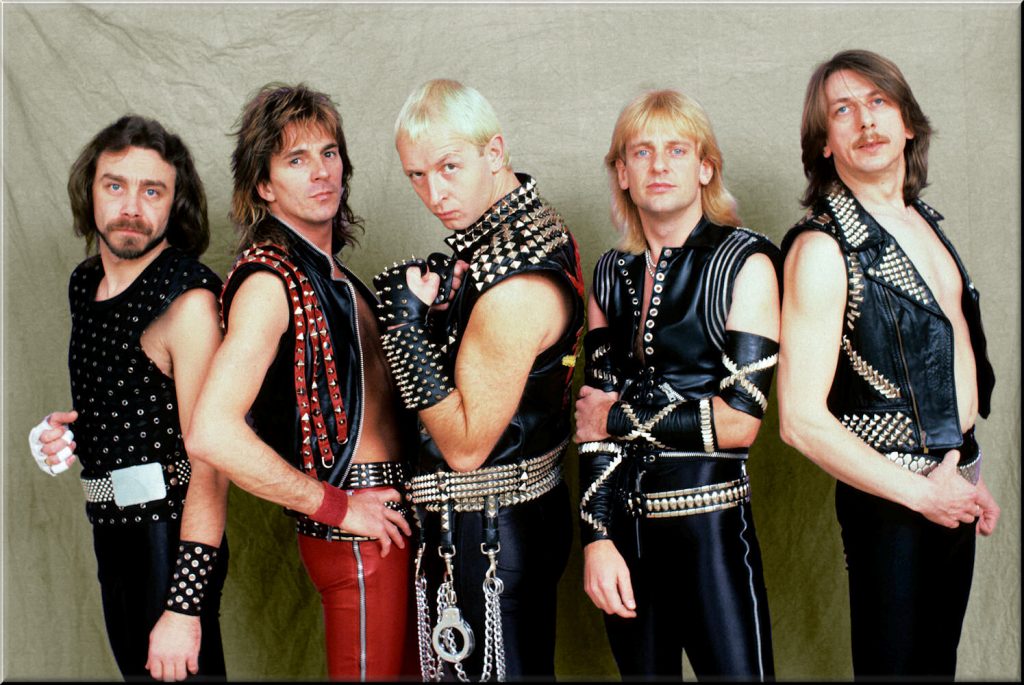Podcast: Play in new window | Download | Embed
Named after a Bob Dylan song, Judas Priest formed in the early 1970’s in Birmingham, England, a town long know as being a city of heavy industry. The core band, which by the time of their 1974 debut LP included Ian Hill (bass), Rob Halford (vocals), Glenn Tipton and K.K. Downing on guitars and featuring a revolving membership on drums (how Spinal Tap) decided, unlike many of their contemporaries at the time, to proudly wave the flag for heavy metal. Metal was considered extremely crude by most in the industry as it carried a truly unsavory tag with its association.
“We were the first band to really go out and claim ourselves to be a real metal band.”
Rob Halford, lead singer, Judas Priest
As punk rock dawned and came to prominence in the U.K., Judas Priest were one of the few bands of any genre playing their type of laser sharp and bone crushing rock. Unlike most metal bands, which were heavily blues influenced, the band opted for a faster, streamlined twin guitar sound, helping to lay the foundation and ride the crest of the highly influential New Wave of British Heavy Metal movement. Priest also pioneered the use of the S&M biker look in music, possibly due in no small part to their lead singer being a gay leatherman.
I remember the reaction by music fans and in particular, Priest fans, when Halford came out. It was basically split into two camps. Camp number 1: “OK, who cares?” Camp number 2: “No, really? Wait a minute…well of course he is. Who cares?” I am not saying that there isn’t homophobia in rock or metal music. However, fans of these particular genres are often considered by outsiders as dumb and intolerant, again displaying the ignorance and prejudice that is often directed at fans of heavy music.

And most disturbingly, queer media and the greater LGBTQi community rarely ever give any thought to the inclusion of Priest and Halford as significant or newsworthy. Far too often, especially when arts reviews happen, or significant persons in the community are spotlighted, this band and their lead singer are often ignored. Just ask Out Magazine, who have no problem listing their 100 prettiest LGTBQi members as long as they fit into a box they can easily categorize and control.
Trust me, the gay men’s Leather community can be just as insular and conservative, which is why I chose this band for this particular series of special pride events. As a gay leatherman myself, a few words: to hell with the haters, to hell with small minds and to hell with liars who attempt to rewrite our history in their own heteronormative, safe for corporate jobs that exploit others image. Fly your freak flag high and blow your speakers. If representation matters as much as some people say it does, represent that.
First Part
- Rocka Rolla (live), 1975, from the Old Grey Whistle Test BBC television show, introduced by Bob Harris
- Breaking The Law, 1980, British Steel
- Hot Rockin’, 1981, Point of Entry
- The Hellion/Electric Eye (live), 1982, U.K. 12-inch promo single
- Tyrant, 1976, Sad Wings of Destiny
- Eat Me Alive, 1984, Defenders of the Faith
Second Part
- You’ve Got Another Thing Comin’, 1982, Screaming For Vengeance
- Stained Class, 1978, Stained Class
- Sinner, 1977, Sin After Sin
- Delivering The Goods, 1978, Hell Bent for Leather (U.S.)/Killing Machine (U.K.)
Finale
- Starbreaker (live), 1979, “Take On The World” b-side
- Diamonds and Rust (live), 1979, Unleashed In The East
Love to you all.
Ben “Bear” Brown Jr., owner
Host, Producer, Audio Engineer and Writer
“Copyright Disclaimer Under Section 107 of the Copyright Act 1976, allowance is made for ‘fair use’ for purposes such as criticism, comment, news reporting, teaching, scholarship, and research. Fair use is a use permitted by copyright statute that might otherwise be infringing. Non-profit, educational or personal use tips the balance in favor of fair use.”
